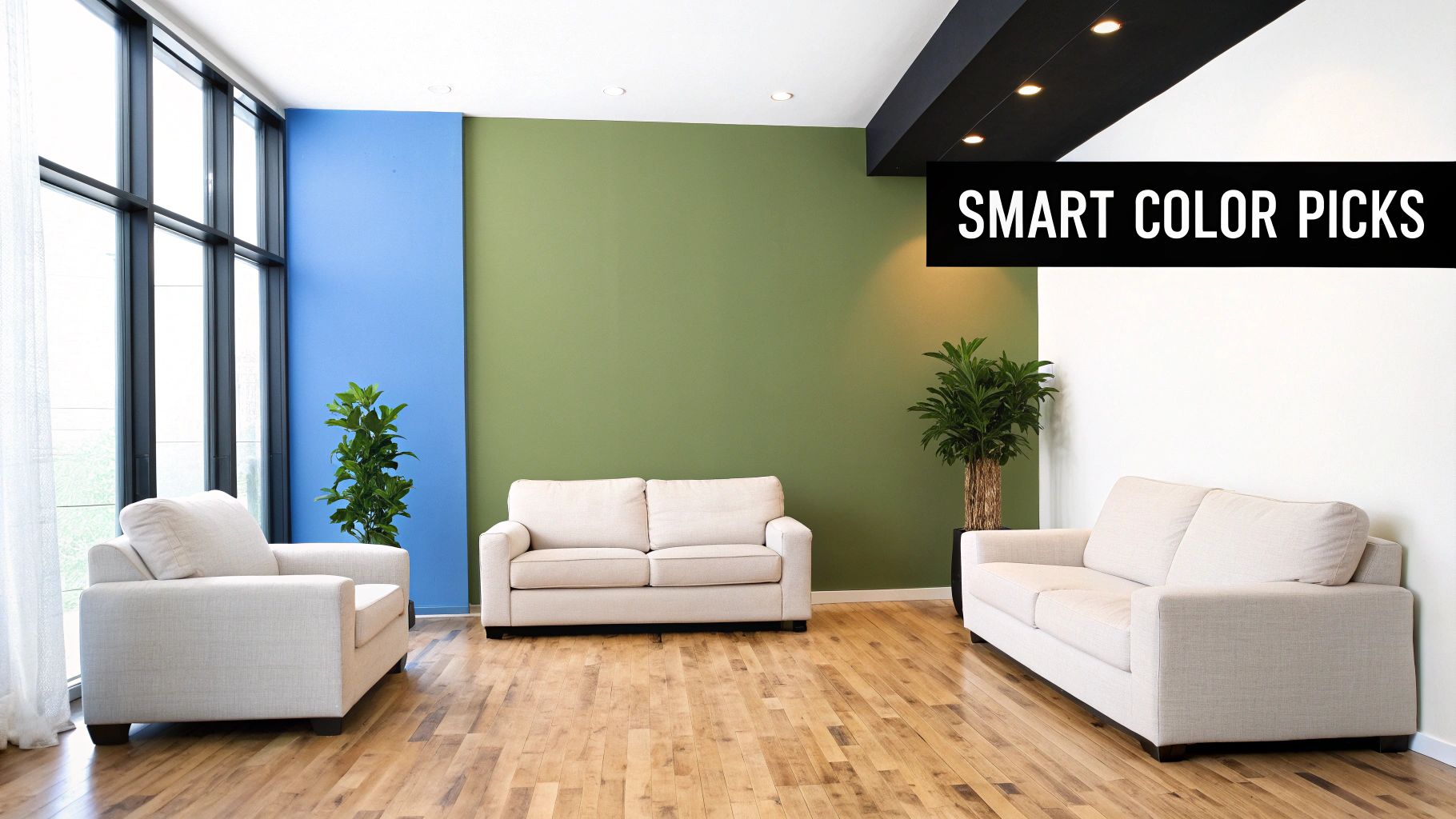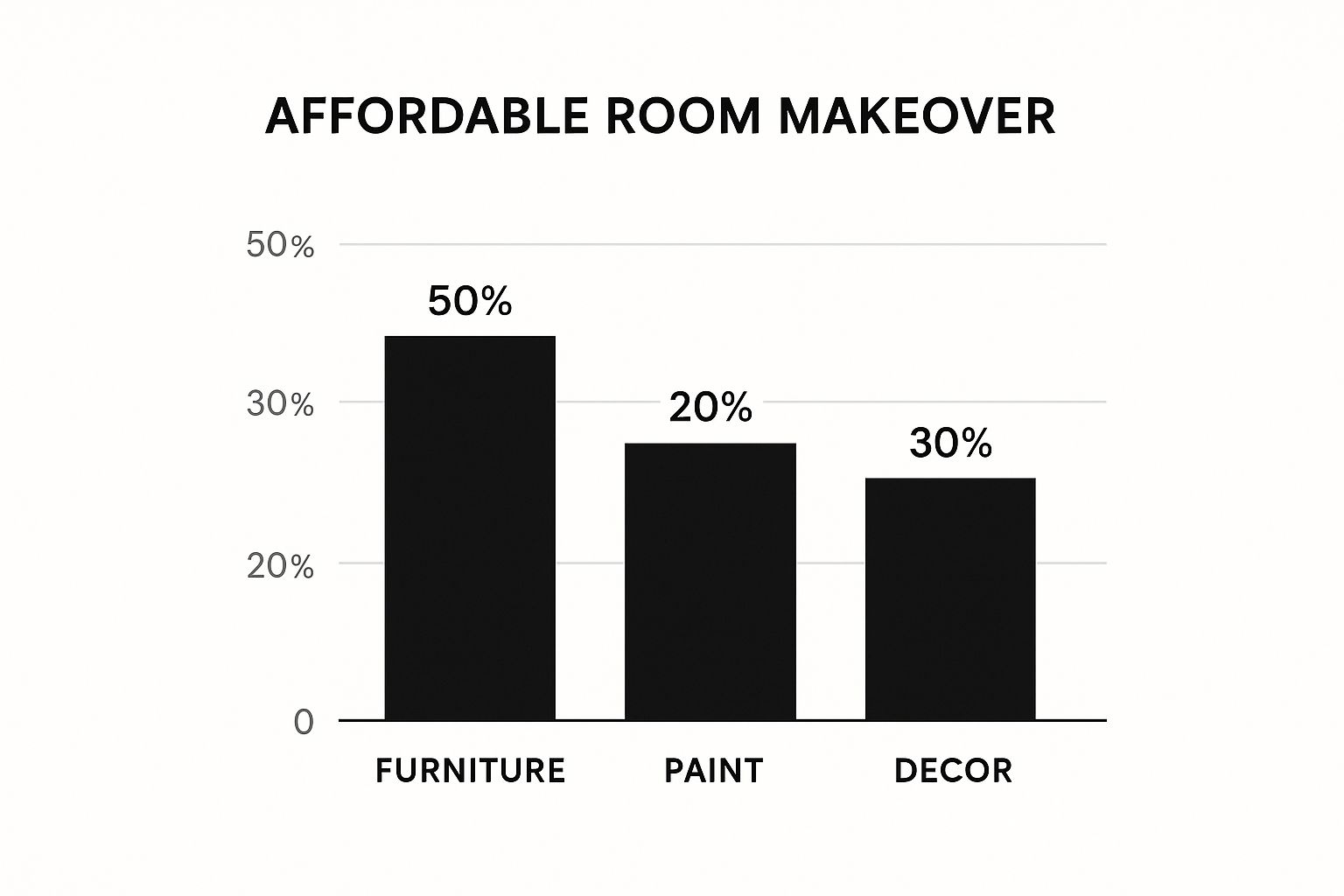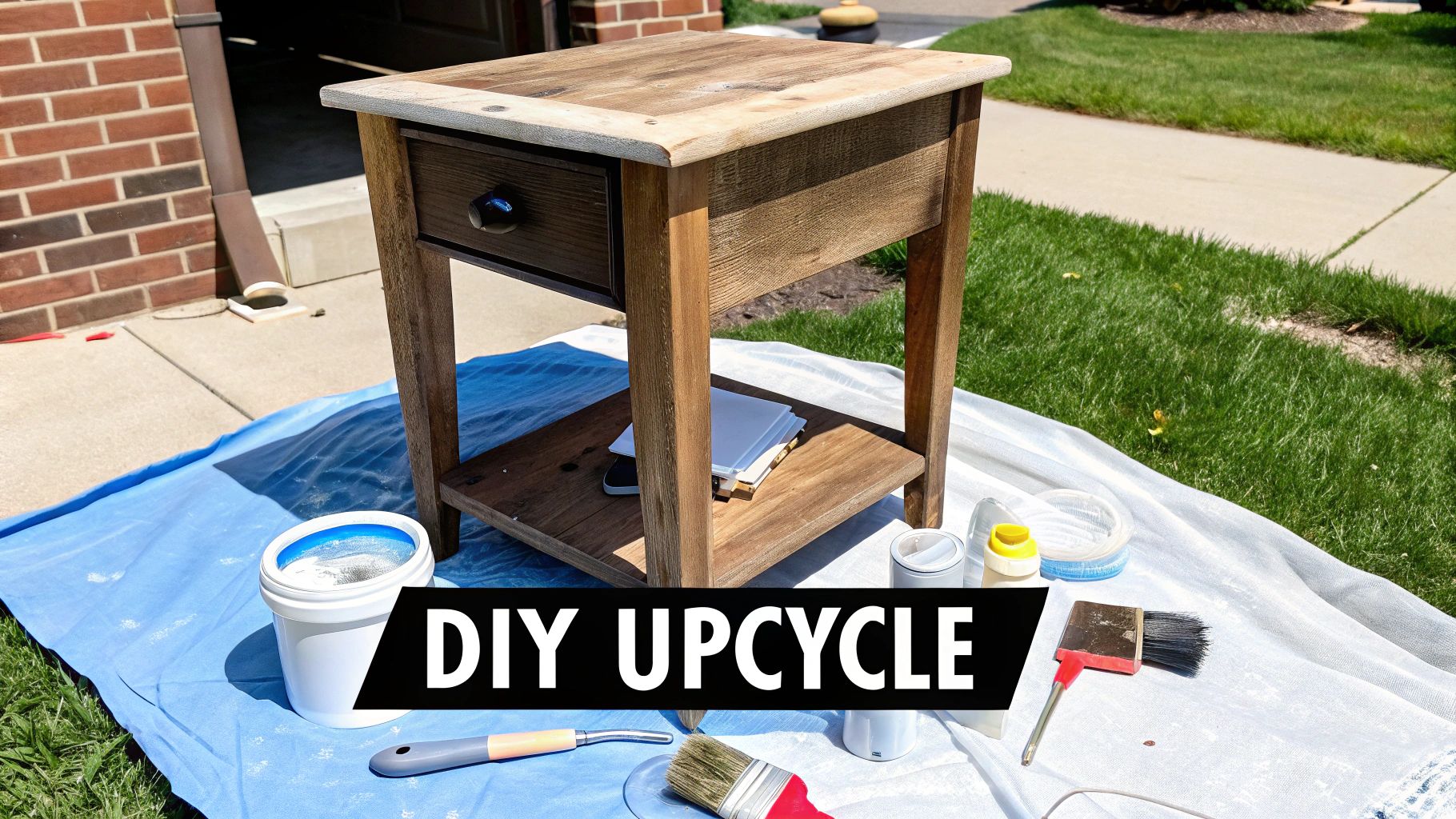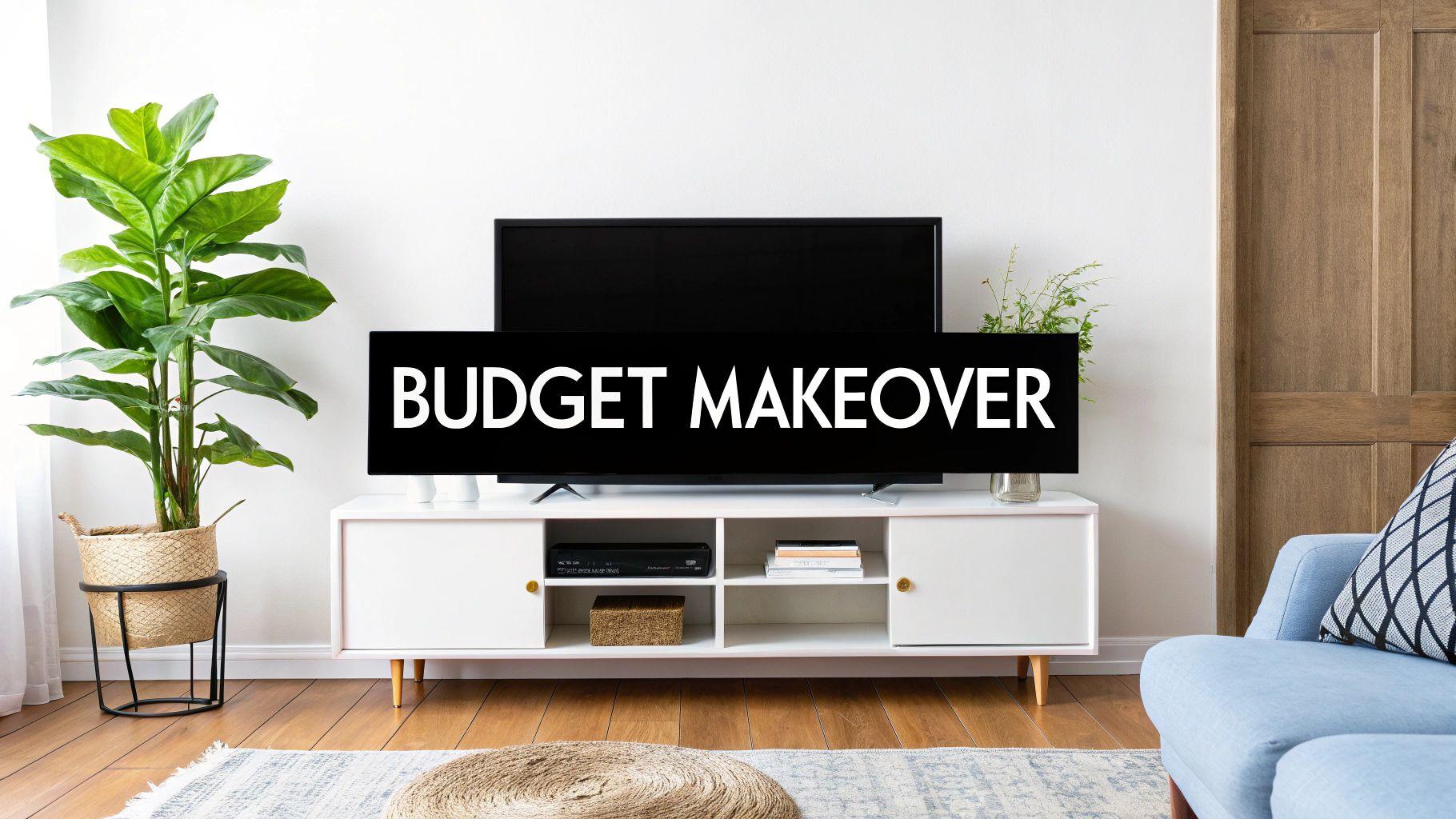Why Affordable Interior Design Is Taking Over
The desire for stylish and functional living spaces is something we all share. However, achieving this dream through traditional interior design services has often been expensive and out of reach for many. Fortunately, a significant shift is happening, making beautiful interiors accessible to everyone, regardless of budget. This democratization of design is driven by several factors, transforming how we create our dream homes.
Functionality Meets Affordability
A key driver of this change is the rising focus on functionality-first design. This approach prioritizes making the most of every space and piece of furniture, naturally leading to cost savings. For instance, multifunctional furniture, like sofa beds or ottomans with storage, serves multiple purposes, reducing the need for—and cost of—extra items. This aligns with the growing popularity of minimalist aesthetics, which simplifies spaces and cuts down on clutter and unnecessary expenses. Embracing DIY projects and readily available online resources further empowers homeowners to personalize their spaces affordably.
Speaking of budgets, the emphasis on affordability is evident in current spending habits. Affordable interior design has gained considerable traction, especially with the rise of DIY projects and budget-friendly online platforms. In fact, as of 2024, the average budget for interior design projects was reported to be around $12,000, reflecting the demand for cost-effective design solutions. Learn more about interior design statistics. This trend is further strengthened by the increasing preference for minimalist and multifunctional designs that offer both cost savings and improved practicality.
The Rise of Savvy DIY and Online Communities
This movement is further fueled by thriving online communities and the increasing number of savvy DIYers. Platforms like Pinterest and Instagram offer endless inspiration and tutorials, empowering individuals to take on design projects themselves. This collaborative online environment fosters a sense of shared knowledge and encourages creative problem-solving, making design more approachable and less daunting.
Technology as a Design Democratizer
Technological advancements also play a vital role in making interior design more accessible. 3D visualization tools are becoming increasingly user-friendly, allowing homeowners to experiment with layouts, furniture arrangements, and color schemes before spending any money. This "try before you buy" approach eliminates costly mistakes and empowers individuals to make informed design decisions. These combined factors are creating a design landscape where stylish, functional, and affordable interiors are within reach for everyone. The future of interior design isn't just about aesthetics; it’s about smart spending, creative solutions, and making the most of every space.
The Smart Money Revolution In Home Design

The interior design world is changing. Stylish, affordable interior design is now within reach for everyone. Professional design is no longer exclusive to the wealthy. Expanding markets, innovative approaches, and increasingly accessible services are making it an exciting time for homeowners looking to create their dream homes.
The Expanding Market and Its Impact on Your Wallet
The growth of the interior design market significantly impacts affordability. Increased competition benefits consumers, encouraging providers to offer competitive pricing and innovative solutions. This makes achieving your dream home more attainable than ever.
The global market is projected to reach $142.41 billion by 2025, growing at 4.3% annually. The interior design services market is expected to reach $88.26 billion in 2025, with a 7.5% growth rate. This expansion is fueled partly by the demand for budget-friendly and sustainable options like modular furniture and sustainable materials. More detailed statistics can be found here: https://cretekala.com/interior-design-market-size/.
Global Trends and Local Impact
Globalization also plays a role in design affordability. Innovative, cost-effective, and sustainable approaches from around the globe are influencing local design options. This influx of ideas increases creativity and market competition, leading to more diverse styles and price points. Ultimately, this means more choices and better prices for consumers.
Leveraging the Competitive Landscape for Premium Results
The rise in accessible design services makes professional-quality help more attainable. Smart homeowners are using this to their advantage, negotiating better prices and securing high-quality services for less than traditional costs. You can create a stunning space without breaking the bank. For those interested in exploring further, this article offers valuable insights: How to master AI in Interior Design.
Real-World Examples of Affordable Transformations
Many homeowners are taking advantage of these market changes to create inspiring spaces, proving that affordable design doesn't mean compromising style or quality. Instead, it's about smart choices and using the many resources now available.
Strategic Shopping That Actually Saves Money

This infographic provides a helpful breakdown of how to allocate your budget for a room makeover. It suggests dividing your resources between furniture, paint, and decor. Notice that furniture takes the lion's share at 50%. Decor comes in second at 30%, with paint accounting for the remaining 20%. This illustrates the importance of focusing your spending on furniture for maximum impact. While paint and decor are important, prioritizing furniture purchases will provide the biggest bang for your buck.
Splurge vs. Save: Making Informed Design Choices
Smart shopping means knowing when to invest and when to save. This strategic approach allows you to stretch your budget and achieve a designer look without breaking the bank. Investing in a high-quality sofa, a piece that sees daily use, makes sense. However, accent pieces, like throw pillows, can be sourced more affordably. This balance allows you to prioritize key pieces without sacrificing style.
Timing Is Everything: Mastering the Art of the Deal
Timing your purchases strategically can significantly impact your bottom line. Look for end-of-season sales, clearance events, and holiday promotions to snag deals on quality pieces. Stay informed by subscribing to store mailing lists and following their social media accounts. Patience and a strategic approach can lead to significant savings.
Secondhand Chic: Finding Treasures in Unexpected Places
Secondhand shopping opens a world of possibilities for the budget-conscious decorator. Thrift stores, estate sales, and online marketplaces like Facebook Marketplace offer a wealth of unique finds. The key is knowing what to look for. Examine furniture for solid construction, durable materials, and any signs of wear and tear. With a bit of research, pre-owned pieces can become statement pieces at a fraction of the retail price. You might even find some inspiration in Free AI Interior Design Apps.
Building Your Dream Space Gradually: A Systematic Approach
Creating a stylish home within a budget takes time. Begin with a plan, prioritizing essential furniture first. Gradually build your dream space, making informed purchasing decisions along the way. This approach prevents overspending and allows flexibility as your personal style evolves.
Real-World Inspiration: Affordable Design Success Stories
Many homeowners have proven that stylish design doesn't have to be expensive. They've successfully transformed their spaces on a shoestring budget, demonstrating the power of resourcefulness. Some have furnished entire rooms for under $500 by combining secondhand finds, DIY projects, and affordable new purchases. These success stories offer valuable inspiration for creating a beautiful and budget-friendly home.
To help you better visualize the different shopping strategies and their benefits, take a look at the comparison table below:
Budget-Friendly Shopping Strategy Comparison
A comparison of different shopping approaches showing cost savings, time investment, and quality outcomes for various furniture and decor sourcing methods
| Shopping Method | Average Cost Savings | Time Investment | Quality Rating | Best For |
|---|---|---|---|---|
| Retail (Sales & Clearance) | Medium | Medium | Medium-High | Budget-conscious shoppers willing to wait for deals |
| Secondhand (Thrift Stores, etc.) | High | High | Variable | DIY enthusiasts and bargain hunters |
| Online Marketplaces | Medium-High | Medium | Variable | Tech-savvy shoppers looking for unique or discounted items |
| DIY Projects | High | High | Variable | Creative individuals and those with specialized skills |
As the table illustrates, each shopping method offers a different balance of cost savings, time investment, and potential quality. Choosing the right strategy depends on your individual needs, budget, and available time. By carefully considering these factors, you can create a stylish home without overspending.
DIY Projects That Create Real Impact

Creating a stylish home doesn't require breaking the bank. Affordable interior design is easily achievable through impactful DIY projects. These projects can revitalize your living space without the need for specialized skills or expensive equipment. This allows you to achieve substantial visual improvements while keeping costs down.
Statement Walls: Maximum Impact, Minimal Cost
One of the most effective DIY projects is the creation of a statement wall. A bold paint color, textured wallpaper, or a curated gallery wall can dramatically alter a room's atmosphere. For instance, a deep blue accent wall can introduce a sophisticated focal point in a living room. Removable wallpaper provides a temporary and budget-friendly way to inject pattern and personality. This type of project is relatively straightforward, requiring minimal tools and offering significant visual impact for the effort.
Custom Storage Solutions: Function Meets Style
Another high-impact DIY undertaking is building custom storage solutions. This might involve constructing shelving units, repurposing existing furniture, or installing drawer dividers. Custom storage not only optimizes space utilization but also adds a personalized element to your design. Floating shelves, for example, can showcase books and decorative items while simultaneously freeing up valuable floor space. This combination of practicality and aesthetics is a core principle of affordable interior design.
Assessing ROI: Time, Skill, and Visual Impact
It's important to remember that not all DIY projects are created equal. Before starting any project, carefully evaluate the time commitment, necessary skills, and potential visual impact. Some projects, such as painting a room, offer a high return on investment with minimal effort. Others, like intricate tiling or electrical work, might be better suited for professional contractors. Recognizing your limitations can save you both time and money in the long run.
Troubleshooting Common DIY Challenges
DIY projects often present unforeseen challenges. Anticipating potential issues and having solutions prepared is essential. For instance, inadequately prepared walls can result in uneven paint finishes. This can be easily avoided by thoroughly cleaning and priming the walls beforehand. Accurate measurements are also vital for building storage solutions to prevent costly errors and wasted materials. Proper preparation is the key to successful and budget-friendly DIY endeavors.
Before & After Transformations on a Budget
Many remarkable before-and-after home transformations have been accomplished with minimal expenditure. Simple upgrades, like replacing cabinet hardware or installing new light fixtures, can significantly enhance a room's appearance. These small yet impactful changes can give a space a refreshed feel for under $100, achieving a look comparable to renovations costing thousands of dollars. Careful planning and execution are crucial for achieving affordable interior design and empowering homeowners to create stylish and functional spaces without overspending.
Technology Tools That Revolutionize Budget Design
<iframe width="100%" style="aspect-ratio: 16 / 9;" src="https://www.youtube.com/embed/7o_MQ3EO-c0" frameborder="0" allow="autoplay; encrypted-media" allowfullscreen></iframe>
Technology is transforming interior design, making stylish and affordable interior design achievable for everyone. Powerful software and apps now allow us to visualize design changes before spending any money, preventing costly errors. This easy access to digital tools is essential for budget-conscious projects.
Visualization Tools: Your Digital Design Assistant
Imagine previewing different paint colors or rearranging furniture virtually before even starting. Visualization tools offer this power. These apps and software allow you to experiment with layouts, color palettes, and furniture arrangements in a digital space. This lets you see how changes will look in your room, saving you from potentially expensive design mistakes.
AI-Powered Design: Personalized Recommendations on a Budget
AI-powered design tools take this even further, offering personalized recommendations based on your room's dimensions, style preferences, and budget. This gives you the benefit of a virtual design consultant, offering advice and inspiration without the high cost of traditional interior design services. For those seeking affordable design options, this technology is proving invaluable. You may find this article helpful: How to master AI in Interior Design.
The growing integration of technology is significantly impacting the affordability of design services. The global interior design software market is expected to hit $8.6 million by 2025. This growth aligns with the increasing popularity of DIY design, empowered by accessible online tools and affordable software. For more statistics, check out this resource: Interior Design Statistics.
Smart Home Integrations: Blending Design and Functionality
Smart home technology offers another way to combine affordable interior design with improved functionality. Smart lighting, for instance, lets you easily adjust the mood of a room, while smart thermostats offer both comfort and energy savings. These integrations add value to your design and enhance the practicality of your living space. This blend of aesthetics and practical benefits is central to the current trend of smarter, more affordable home design.
Room-By-Room Transformation Blueprint

This blueprint offers a room-by-room guide for achieving affordable interior design. The focus is on maximizing impact without breaking the bank. Each room offers unique opportunities for budget-friendly updates. By understanding these nuances, you can strategically allocate your budget and create a cohesive design throughout your home.
Living Room: Creating a Welcoming Focal Point
The living room is often the heart of the home. This makes it an ideal space for a budget-friendly makeover. Prioritize improvements that create a welcoming atmosphere and improve the room's functionality.
- Focal Point: Highlight a fireplace or a feature wall. A fresh coat of paint, a gallery wall, or strategically placed mirrors can create a stunning focal point.
- Furniture Arrangement: Consider how your furniture is arranged. Optimizing furniture placement can maximize space and create a natural flow, making the room feel larger and more inviting.
- Lighting: Ambient lighting, using affordable lamps and well-placed mirrors, can amplify natural light and dramatically change a room's ambiance without major renovations.
Bedroom: Designing a Tranquil Retreat
The bedroom should be a sanctuary for relaxation. Affordable interior design principles can create a tranquil retreat without emptying your wallet.
- Textiles: Incorporate soft textures through bedding, curtains, and rugs. This simple addition enhances comfort and creates a luxurious feel without the need for expensive furniture.
- Decluttering: A more peaceful and organized space can be achieved by maximizing storage solutions and minimizing clutter. This enhances both the aesthetic and functionality of your bedroom.
- Color Palette: Choose calming colors that promote relaxation. Soft blues, greens, or neutral tones can create a serene atmosphere conducive to restful sleep.
Kitchen: Enhancing Functionality and Style
Kitchens are often the busiest rooms in a home, so affordable interior design here should focus on practicality and maximizing space.
- Cabinet Hardware: Updating cabinet hardware is a quick and inexpensive way to refresh your kitchen's appearance.
- Backsplash: A new backsplash can dramatically transform your kitchen’s look without a full-scale remodel.
- Lighting: Improve task lighting with under-cabinet lights. This enhances both functionality and the overall ambiance of the space.
Bathroom: Creating a Spa-Like Oasis
Transforming your bathroom into a relaxing oasis doesn't require a fortune. These affordable interior design ideas can elevate your bathroom experience:
- Mirrors: Replacing or upgrading your mirrors offers an instant update. Larger mirrors can also create the illusion of more space.
- Textiles: Plush towels, bath mats, and a stylish shower curtain instantly create a luxurious, spa-like atmosphere.
- Storage: Keep your bathroom clutter-free by maximizing storage space with shelves, baskets, and organizers.
To help you visualize your design project and create realistic renderings, consider using InstantInterior AI. This tool allows you to experiment with different styles and layouts based on your photos and preferences.
The following table provides a budget breakdown for each room, allowing you to prioritize your spending for maximum impact:
Room-by-Room Budget Breakdown
A detailed breakdown showing average costs for essential improvements in different rooms, helping readers prioritize their spending for maximum impact
| Room Type | High-Impact Changes | Average Cost | DIY Potential | Time to Complete |
|---|---|---|---|---|
| Bedroom | Bedding, Curtains, Decluttering | $100 - $300 | High | Weekend Project |
| Kitchen | Cabinet Hardware, Backsplash | $150 - $400 | Medium | 1-2 Weekends |
| Bathroom | Mirrors, Textiles, Storage | $50 - $200 | High | Weekend Project |
By following these room-by-room tips, you can implement affordable interior design strategies and create a stylish and functional home without overspending.
Creating The Expensive Look For Less
The secret to affordable interior design isn't necessarily about minimizing your spending. It's about maximizing the impact of every dollar. Just like a chef can create a gourmet meal with budget-friendly ingredients, you can achieve a high-end look by focusing on technique and presentation. Let's explore the tricks professional designers use to make any space look magazine-worthy.
The Psychology of Color and the Power of Texture
Color significantly impacts the mood and perceived value of a room. A sophisticated, neutral palette, such as soft grays, warm creams, or muted blues, creates a timeless and elegant backdrop. This approach not only evokes a sense of calm but also makes the space feel more expansive and luxurious. Adding layers of texture, like a chunky knit throw on a velvet sofa, creates visual depth and interest. This interplay of textures adds a rich, inviting ambiance that hints at quality, much like combining different fabrics in a well-put-together outfit.
Strategic Styling: Elevating Inexpensive Pieces
Styling is where the true transformation happens. Think of budget-friendly furniture as your blank canvas. Strategic styling is how you turn those pieces into something special, giving them a custom, high-end feel. Something as simple as adding decorative trays, books, and candles to a coffee table instantly elevates the entire look. Grouping similar items together creates a curated and intentional feel, giving the space a more polished and professional appearance. This meticulous attention to detail is a hallmark of successful affordable interior design.
Finishing Touches That Make All the Difference
Small details often have the biggest impact. Carefully chosen throw pillows, strategically placed artwork, and the right lighting can transform a room from ordinary to extraordinary. Just as a carefully chosen piece of jewelry completes an outfit, these finishing touches add personality and refinement. They create a cohesive, sophisticated look that speaks volumes, pulling everything together for a truly luxurious feel.
Avoiding Common Budget Design Mistakes
Just as certain fashion choices can date an outfit, some design choices can instantly reveal a budget makeover. For instance, using too many small, mismatched accessories can clutter a room, making it appear cheap. Instead, opt for a few larger, statement pieces for a more impactful and polished presentation. Another frequent mistake is neglecting lighting. Proper lighting is crucial for a warm and inviting atmosphere. Simple adjustments like adding a floor lamp or replacing harsh overhead lighting with softer bulbs can make a dramatic difference.
Styling Secrets to Make Budget Finds Look Designer
The art of affordable interior design involves transforming budget-friendly finds into statement pieces. A simple thrift store vase can look like a designer piece with a fresh coat of paint and some strategically placed greenery. An inexpensive rug can be elevated with a stylish rug pad and layered with smaller, textured rugs. These clever styling secrets unlock a high-end look without the high-end price tag.
Ready to transform your space without breaking the bank? InstantInterior AI can help you visualize your dream design and create stunning, photorealistic renderings in minutes. Start your free design today and discover the power of affordable interior design with AI. Start your design journey now!
Article created using Outrank
